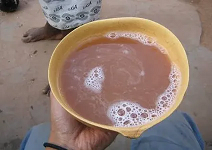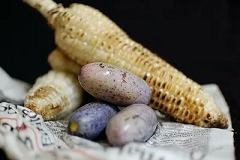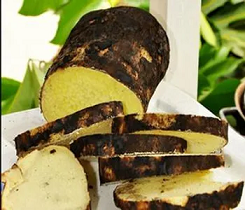Tiv people
 | |
| Total population | |
|---|---|
| Approx. 5 million[1] | |
| Regions with significant populations | |
| Nigeria, Cameroon | |
| Languages | |
| Tiv, Tivoid languages, English, French | |
| Religion | |
| Predominantly Christian, Tiv Traditional religion | |
| Related ethnic groups | |
| Other Tivoid peoples |
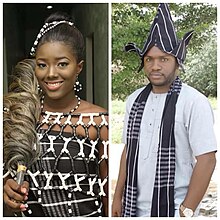


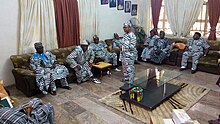

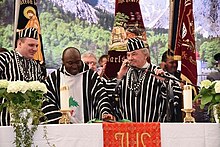




Tiv (or Tiiv)[2] are a bantu ethnic group. They constitute approximately 2.4% of Nigeria's total population,[3] and number over 5 million individuals throughout Nigeria and Cameroon.[4] The Tiv language is spoken by over 5 million people in Nigeria, with a few speakers in Cameroon. Most of the language's Nigerian speakers are found in Benue, Taraba, Nasarawa, Plateau, Cross rivers, Adamawa, Kaduna, and the Federal Capital Territory Abuja. The language is a branch of Benue–Congo and ultimately of the Niger–Congo phylum. In pre-colonial times, the Fulani ethnic group referred to the Tiv as "Munchi" (also sometimes written Munshi e.g. Duggan, E. de C. 1932),[5] a term not accepted by the Tiv people.
History
[edit]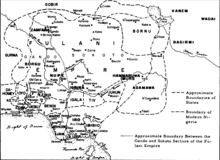
The Tiv believe they emerged into their present location from the southeast of Africa. It is claimed[6] that the Tiv left their Bantu kin and wandered through southern, south-central and west-central Africa before returning to the savannah lands of West African Sudan via the River Congo and Cameroon Mountains and settled at Swem, the region adjoining Cameroon and Nigeria at the beginning of 1500, which was originally Bantu craddle and home C.E.[6] "Coming down," as they put it was in batches.[7] Some moved southward across Obudu Plateau, others moved downward spreading over Mdema and Waka district which is present day central and Southern taraba, while others moved into the Benue valley in present day central Nigeria.[8] These dispersions took place in the early 1500 CE to 1600 CE.
Over time, as social interactions began and new migrants came into Nigeria, they mingled with Fulani at their northern axis to which they foster a relationship calling each other "Jo". Hence Tiv people called Fulani as fulanijo, Fulani in turn called Tiv, tivjo. The fulani also called them munchi. Which the Tiv see as derogatory and unacceptable.[9]
The Tiv people were a free people without a king; hence every clan or kindred was administered by the eldest man called "Orya". They were amongst the first inhabitants of the Benue Valley (according to Mark Cartwright's[10] record of Bantu migration) before other tribes finally migrated to join them. Due to their peaceful disposition and dispersed nature of living, with no Central government nor king, they posed no threat to new migrants to the region who cohabited with them until the coming of the Europeans. The Europeans first contact with Tiv was in the 18th century. Note that the time of encounter with the Europeans does not mean their time of migration. Their late recognition was due to the lack of kingship which became a big disadvantage to Tiv in Nigeria because the colonial masters preferred working with kings, which prompted the Tiv to clamor for and install a king( Tor Tiv) in the 1940s.[11]
When the Tiv were found on the banks of the Benue River and were discovered to be distinct from other ethnic minorities, and were the major occupants of the Benue Valley, much curiosity aroused and immediately the Europeans identified them as the bantus before doing other comprehensive studies on all other aspects of their culture. This was because the Europeans had previously encountered other bantu groups in central and southern Africa.[12]
The British forces entered the tivlands from the east in 1906, when there was tension between the Tiv and other minorities within the Benue valley. The tiv approach to battle, fighting techniques, weapons, physique and facial structure wasn't any different from other bantu groups they have encountered in Southern and Central Africa. The Tiv said in 1950 that they had defeated this British force, then later invited the British in for negotiations. The southern area was penetrated from the south-south; what the southern Tiv people refer to as "the eruption" of the British there occurred in 1911.[13]
The Tiv came into contact with European culture during the colonial period. During November 1907 to spring 1908, an expedition of the Southern Nigeria Regiment led by Lieutenant-Colonel Hugh Trenchard came into contact with the Tiv. Trenchard brought gifts for the elders. Subsequently, roads were built and trade links established between Europeans and the Tiv.[14] But before the construction of roads began, a missionary named Mary Slessor went throughout the region seeing to the people's needs.[15]
The Tiv people and their lands were hence the last area in Nigeria of consequence to be brought under the British control.
Social and political organization
[edit]Most Tiv have a highly developed sense of genealogy, with descent being reckoned patrilineally. Ancestry is traced to an ancient individual named Tiv, who had two sons; all Tiv consider themselves a member either of Ichongo (translated in English as circumcised) or of Ipusu[16] (translated in English as uncircumcised). Ichongo and Ipusu are each divided into several major branches, which in turn are divided into smaller branches. The smallest branch, or minimal lineage, is the ipaven.[17] Members of an ipaven tend to live together, the local kin-based community being called the "tar".[18] This form of social organisation, called a segmentary lineage, is seen in various parts of the world, but it is particularly well known from African societies (Middleton and Tait 1958).[19] The Tiv are the best-known example in West Africa of a society of segmentary lineage, as documented by Laura Bohannan (1952) and by Paul and Laura Bohannan (1953); in East Africa, the best-known example is the Nuer, documented by E.E. Evans-Pritchard (1940).
The Tiv had no administrative divisions and no chiefs nor councils. Leadership was based on age, influence and affluence. The leaders' functions were to furnish safe conduct, arbitrate disputes within their lineages, sit on moots and lead their people in all external and internal affairs.[20]
These socio-political arrangements caused great frustration to British attempts to incorporate the population into Colonial Nigeria and establish an administration on the lower Benue. The strategy of indirect rule, which the British felt to be highly successful in regards to ruling over the Hausa and Fulani populations in Northern Nigeria, was ineffective in a segmentary society like the Tiv (Dorward David Craig 1969).[21] Colonial officers tried various approaches to administration, such as putting the Tiv under the control of the nearby Jukun, and trying to exert control through the councils of elders ("Jir Tamen"); these met with little success. The colonial administration in 1934 categorised the Tiv into Clans, Kindreds, and Family Groups. The British appointed native heads of these divisions as well.
Members of the Tiv group are found in many areas across the globe, such as the United States and United Kingdom. In these countries, they hold unions, known as MUT[22] (Mzough U Tiv, or Mutual Union of Tiv in English), where members can assemble and discuss issues concerning their people across the world, but especially back in Nigeria. The arm of the MUT serving the United States of America is known as MUTA (Mzough U Tiv ken Amerika, or Mutual Union of the Tiv in America), for instance.[23]
Language
[edit]The tiv people have always had their history in oral tradition and have had all the Tiv people to speak the language. There is no evidence of an ancient script or write up of the language.
The first reference to the language was by Sigismund Koelle in 1854 from freed slaves in Sierra leone according to his study Polyglotta Africana.
The tiv language classification has been debated as either semi-Bantu or bantu. Even though, Sir Johnston Harry H.[24] classified it in 1919 and later Talbot P. Amaury in 1926 as Semi-Bantu, Roy Clive Abraham[25][26]together with the South African missionary, Rev W. A. Malherbe in 1933 classified it as bantu after making a complete linguistic study of the language. Abraham stated that the language vocabulary of the Tiv people and the East African Nyanza group have a lot of similarities.
Society and culture
[edit]Religion and culture
[edit]The Tiv are predominantly Christians. Chritianity dates back to 1911 when the first Dutch missionaries from Dutch Reformed Church of South Africa arrived at the Tiv village in Katsina-Ala local government of Benue State called Sai. They established the N.K.S.T church or Church of Christ in the Sudan Among the Tiv.
Dressing (A'nger)
[edit]The traditional attire is the black-and-white-striped anger.[3] When the Tiv people arrived at their current location several centuries earlier, they discovered that the zebra they used to hunt for meat and skin, used for ceremonial attire, was not native to the area. When they acquired the skill of the loom, they decided to honor their heritage by weaving a cloth with black-and-white stripes, reminiscent of the zebra skin; this would then be made the preferred attire. Initially, it was a simple cloth to be draped around the torso. Nowadays, it is made into elaborate robes, such as those worn by the traditional rulers and elders – from the Tor Tiv downwards.
The black-and-white color of the necklaces worn by the traditional rulers has been chosen to match the robes.
Other Tiv cultural clothes are
Ivavtyo, Lishi, Gbev-whaa, Godo, Tugudu, Chado, Deremen, Gbagir, Anger etc.
Circumcision and body scarification
[edit]In Tiv mythology and history, Circumcision is almost as old as the Tiv language itself. Tiv who is the progenitor of the tiv people had two sons; Ichongo which means circumcised, Ipusu which means uncircumcised. The two sons are the two major houses on which the tiv kingship is rotated upon.
Circumcision has evolved with time among the Tiv people. Today, it is performed a few days after childbirth at the hospitals. Circumcision practiced in Central Africa[27]among the Bantu peoples evolved as each group spread out.
Between the 18th and 20th centuries, the Tiv circumcised the male children when they became teenagers. A pickaxe (ityogh) was the tool of choice and then a razor blade (atsem) became popular in the 20th century.
During the Tiv-Fulani cohabitation, the Tiv people carried no ethnic facial marks nor any bodily cicatrices. After the separation with the Fulani, they adopted some distinct body tattoos in other to distinguish themselves from other tribes just the way the Fulani did.
The young men tattooed their faces, pierced their ears and sometimes sharpened their teeth. The young ladies tattooed their abdomens and pierced their ears.[28]
Music and entertainment
[edit]Locally made musical instruments were traditionally used for political, ceremonial communication and entertainment.[29] The key instruments follow.
Kakaki
[edit]The kakaki is a royal trumpet used in many West African groups in Nigeria, Niger, Chad and Burkina Faso.[30] This is an instrument used to convey special messages to the people of the community, such as the birth of the child of the King, his naming ceremony, the crowning of a new king, or to gather people together during the marriage ceremony of the king and the king's son's marriage ceremony.[31] This instrument was used to convey all the messages to the people to assemble at the square for the ceremony. When there is an enemy attack on the community, a warning sound of the Kakaki is blown to alert those who can defend the society and every citizen to be alert.[32]
Ilyu
[edit]A light wooden instrument, the ilyu was used to pass messages to the people of the village, probably for the invitation of the people for a particular meeting of the elders at the king's palace or for the people to gather at the market square for a message from or by the king. Up until today, it is the main instrument for the celebration of newly wedded couples (marriage reception ceremony or Kwase-kuhan).[33]
Indyer
[edit]The indyer is a heavy wooden instrument carved out of mahogany trunk through some mysterious way; myth has it that a chosen carver turns into a worm to create the large hollow in the cut trunk, leaving only a small opening (like in a medical operation). This belief is perhaps due to the fact that the carvers are reluctant to explain the technique employed for such artistic finesse. The indyer, believed to be connected with high magico-spiritual potency, is not played for secular purposes except for special occasions as sanctioned by the elders. It is used to communicate the death of an important personality in the community or to communicate a serious happening in the community, like a call to war.[34]
Akya
[edit]It is used together with the agbande (drums) combined with the ageda at festivals to pass a message across to the people for a call for the display of culture.
Adiguve
[edit]It is an instrument like a violin, used for music and dances in conjunction with Agbande (Agbande) at festivals and dance occasions, sometimes to announce the death of a leader or an elder of the community. During this period it is played sorrowfully for the mourning of the dead. It is mostly played at funerals.
Gbande
[edit]Agbande (plural) are a set of crafted wooden musical instruments used to complement agbande at festivals. They are particularly large and are played by the young men of the community. Special drum beats communicate special messages and music for the festivals to come and during the festivals, for instance, royal occasions such as the coronation and funeral.
Ortindin (Ortyom) – Messenger
[edit]Usually, he is chosen by the elders of the community to do errands for the elders and the leader of the community. He is sent out to the heads of the neighbouring families for a crucial meeting at the head of all the leaders of the community.
Kolugh ku Bua
[edit]This is an instrument similar to the shofar, made out of cow horns. There are farmers' associations that use this instrument when they have a job to do; for instance, when they are invited to make ridges on a piece of land, the Public Relations Officer (PRO) of the association will use this medium to wake up the members for the work they have for that day.
Indigenous communication is not only vertical, from the rulers to the subjects, but is also horizontal. Individuals communicate with society through physical and metaphysical means. A farm owner, for example, may mount a charm conspicuously on his farm in order to stress private ownership and to scare off human intruders.
The fear of herbalists and witches influences social behaviour considerably.
Rainmakers communicate their power to disrupt events through various psychological means. Village sectors in Africa communicate mostly via the marketplace of ideas contributed by traditional religion, observances, divination, mythology, age-grades, the Chiefs courts, the elder's square, secret and title societies, the village market square, the village drum (gbande) men, indeed the total experiences of the villager in his environment.
Unlike the mass media, access to the native media is culturally determined and not economic. Only the selected group of young men or the elders can disseminate information generally. The young only disseminate general information about events and the social welfare of their communities using the media mentioned above.
The Tiv people of Benue state still practise some of this traditional system of communication, using the Kakais, Agbande, Indyer, Adiguve, Ilyu, etc. Nevertheless, the increase in the western world media is threatening the cultural communication system.
Many of the communities in Benue state still use these instruments to convey messages to the people of their community, and it is helping a great deal, since there is a language barrier between people with the introduction of the western world's means of communication, using a western language (English) to convey information.
Drama
[edit]The Tiv use a style of performing arts called Kwagh-hir.[35] It is a storytelling method which uses carved masks and puppetry as a form of masquerade. Masquerade is used as a way for individuals of Tiv culture to express themselves. The Tiv use this style as a way to hide their identity and take the role of spiritual beings known as adzov.[36] The performers hide their identities, only to be revealed by their individual styles at the end of the performances.[37]
Tiv plays The Tiv use their plays as a way to tell traditional legends, retell events, and politics.[38] A few popular plays in Tiv culture include:
- A Close Shave - Chris Kyoive
- Sons of Akpe - Boniface Leva
- Adan Wade - Suemo Chia[39]
Traditional marriage in Tiv culture
[edit]Marriage is, of course, one of the prominent features of Tiv culture, which is quite rich and developed in many areas. Traditional marriage among the Tiv is still seen as a significant cultural occasion.[40] Tiv's marriage is not just the union between a husband and a wife but the entire family.[41][42]
Yamshe: This type of marriage was practiced by the fore-fathers and involves the exchange of sisters to marry couples. Previously, two men might swap sisters or families, exchanging daughters for spouses.[41] A man looking for a wife who comes across another looking for a wife will exchange daughters or sisters.[16]
Kwase Tsuen: This is a union induced by captivity. A man would kidnap a girl forcefully, or a family would do it for their son. It is used in some remote Tiv areas.[41][16]
Iye: In Tiv land, courtship or dating is the norm. The man meets a girl, pays her additional visits, and gives his family some things. Sometimes the girl and the man decide to run away secretly with the intention of getting married without parental consent, and sometimes the girl is taken home after the man pays the bride price.[41]
Kwase- Kemen: This is a type of marriage that is currently practiced in Tiv Land: bride-price marriage. After extensive courtship (Iye), the man visits the girl's family, pays the money, and offers the gifts the girl's family listed.[41]
In 1927, the intricate Tiv system of trade marriage was abolished and bride-wealth marriages took its place[43]
Tiv's traditional marriage attire
[edit]Tiv people dress in vibrant colors, and the groom and bride's outfit appears to be among the most significant aspects of a wedding. The garments produced with A'nger material have black and white stripes, which are the most constant feature.[44] Without a variety of accessories, such as headpieces, bracelets, or necklaces, wedding apparel is also unattainable. Beads in shades of black and white are the most common type.[45]
Cuisine
[edit]The common Tiv food are mostly solid, cooked, pounded or prepared with hot water. They are mostly carbohydrates or by-products of yams (iyou), cocoyam (mondu), cassava (alogo), beans (alev), corn (kyuleke), etc. The Tiv are known to be the food basket of Nigeria.[46]
Tiv have been identified by the British with the sesame seed as the British named it Beni-seed because it was the major cash crop exported to Europe and other colonies from the Benue valley.[47]
Some common Tiv foods are ruam kumen(pounded yam), ruam nahan(fufu), pete(yam pottage), Akuto(sweet potato pottage), akpukpa(Okpa), Ibyer(fermented cereal pudding) etc.
- Soups: Ichegh, Pocho, ager, ive, genger, atyever, tur, vambe, igyo, agbende ashwe, mngishim(garden egg soup), ashwe, Atuur, vegetable soup, ijôv (mushroom soup), aninge, furum`, adenger, gbungu, gbande.
- Tiv staples: Roasted yams, ahuma, Jollof rice, fried yams, kuese etc.
- 'Beverages: tyo, burukutu, atemba a suwanbin, ibyer.
- Snacks: Peanuts and sesame (beni-seed), asondo (dried sweet potatoes), igbough ahi (roasted or boiled bambara nuts), mzembe (roasted pears), huu (roasted termites), kuese (beans cake), N'gyata (peanut paste).
- Tiv cultural dishes
-
pounded yam and assorted soup
-
Burukutu
-
peanuts and sesame
-
Ibyer
-
kyegh sha ishwa
-
Mzembe or pears
-
Roasted yam
Demographics
[edit]Cameroon
[edit]According to the 2005 census results in Cameroon,[48] there were 87, 252 [49] Tivoid people at Akwaya sub-division, located at the south-western border of Cameroon Manyu division, with Mamfe as its capital, which is 74km away from the south eastern Nigerian border. The paramount ruler is Zaki Abaajul.[50] The Cameronian Tiv are well educated and live in Anglophone Cameroon[51] as their ancestral land, while a few others live in the francophone region. They are mostly farmers but others work in the government. Some of their villages are bagundu, njawbaw etc.
The Ikyurav-tiev of Katsina-Ala were some of the last Nigerian Tiv people to migrate from here. They are still known in Cameroon as the Ekol. According to Nkwain, N. and Bomono, H, the founding father of the Ekol clan is of the Munshi ethnic group in Nigeria. He was known as Ekol and had four sons namely Ehow, Vitulu, Ewan and Njaw. They established separate independent towns in their names and then 3 out of 4 of the group migrated to settle in Katsina Ala. Only the Njaw were left in Cameroon which are the natives of the Njawbaw village in Messaga Ekol court area.[52]
Although some Nigerian Tiv people are unaware of some of the Tiv groups of the Cameroon because of the international border but, these groups always consider themselves Tiv because they are basically the same people lost in undocumented history. Some of them have an additional dialect to the main Tiv language. They also constitute some of the major tiv clans in Nigeria like the Iyon(Kwande), Utange(Ushongo) etc.
The Cameroonian Tiv groups are; Bitare, Mesaka, Iyive, Ceve or Becheve, Evant, Eman, Ipulo, Caka etc. They together with the Tiv in Nigeria share the same culture, language, History, Religion, and Tradition. They occupy a total of 99 villages in the Akwaya sub-division covering an area of 3,682 square kilometers, which is their major homogenous population.
Nasarawa state
[edit]The local governments with the highest concentration of Tiv people in Nasarawa state are; Doma, Nasarawa, Lafia, Obi, Keana, and Awe Local Government Areas.
Here they live in the southern part of the state which is also the south senatorial district. The tiv clans here are the Isherev, Utyondu, Nongov and kunav.[53] They have lived here since the 16th century which predates the colonial era. They live with other tribes like the Koro, Gwandara, Kamberi, and Alago.[54]
In the early 60s and colonial times, The Lafia division was different from the munshi(tiv) division.[55] The population of the Tiv in the Lafia division in 1963 was recorded to be 289, 559 people. The total population of the Lafia division in 1963 was 424, 219 people.This gave the Tiv 49.2 percent of the total population. The 1991 census however did not show demographics by tribes but this alone makes Tiv the dominant ethnic group in the Nasarawa south senatorial district.[56]
Notable people
Hon Athanasius Tyo --- 1979 – 1983 House of representatives Awe, Keana, Doma federal constituency.
Emmanuel Orshio – 1983 House of representatives Awe, Keana, Doma federal constituency.
Solomon Ihuman --- Commissioner for culture and tourism.
Philip Audu -------- Permanent Secretary water resources.
Taraba state
[edit]The Ukum, Ugondo, Shitile, Kunav, Gaav and Shangev clans are the predominant Tiv clans in Taraba state. They were some of the first migrants together with the Chamba tribes between 1750 and 1800.[57] Their largest populations are in Bali, Donga, Ibi, Gassol, Takum, Gashaka, Kurmi and Wukari Local Government Areas.[58]
There are also other Tivoid groups like the Batu, Abon, Bitare and Ambo in Sardauna Local government area.
Some of the popular towns and villages with a homogenous tiv population are, Tor Damsa, Tse Afogba, Tse Kpandi, Tor luam, Deke, China etc.
Notable people
Hon. Charles Tangu Gaza - 1959 Federal House of Representatives.
Hon. Simon I. Awuah- Gongola State House of Assembly in 1979-1983.
Hon. David K. Mtuam - Gongola State House of Assembly in 1979-1983.
Hon. Simon I. Musa - First Chairman of Wukari Local Government in 1979-1983.
Hon. Hitler Gbaondo - Takum Federal Constituency in the House Representative in 1979-1983.
Hon. Tsetim Gwakyaa - Donga Federal Constituency in the House of Representatives in 1983.
Mr. Daniel Orkuma Nav- Former Permanent Secretary, Government House administration.
Mrs. Rebecca Torpeva - Former Adviser to the Governor on political affairs.
Dr. Tor-Agbidye - Former adviser to the Governor.
Mr. Emmanuel Orabunde- Former INEC Commissioner.
Anna Darius Ishaku - Former first lady of Taraba state.
Shaakaa Chira - Auditor-General of the Federation
Plateau state
[edit]There are over 50 tribes in Plateau State. The first seven in order of numerical strength are; Berom, Mwaghavul, Tarok, Angas, Jawara, Bassa and Tiv.[59]
Tiv-speaking populations are found in Langtang South, Shendam, Qua'an-Pan and Wase area councils.[60]
Cross River state
[edit]Yala, Bekwarra, Obudu and Obanliku Local Government Areas.
Together with other tivoid groups like the Utanga, Ceve or Becheve, Evant, Eman etc.[61]
Benue state
[edit]Tarkaa, Makurdi, Gwer East, Gwer West, Ukum, Logo, Konshisha, Gboko, Kwande, Vandeikya, Katsina Ala, Guma, Buruku, and Ushongo Local Government Areas.
Notable people
[edit]Civil servants, politicians and activists
[edit]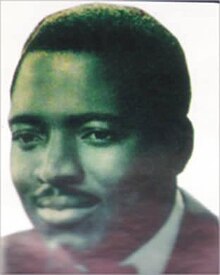

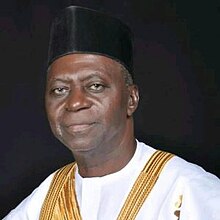
- Joseph Tarka, politician, human rights activist
- Barnabas Gemade, former PDP party chairman
- Aper Aku, first civilian governor of Benue state
- George Akume, former senate minority leader
- Iyorchia Ayu, former senate president
- Prof. Ignatius Akaayar Ayua, SAN, OFR, FNIALS, former Permanent Secretary Ministry of Justice, Author
- Chaha Biam, former speaker house of representative
- Gabriel Suswam, politician former governor of Benue state and a serving senator
- Terhemba Shija, politician, academic, poet.
- Samuel Ortom, former State Governor
- Hyacinth Alia, the current State Governor
- James Ayatse, Tor-Tiv V
- Daniel Saror, former minority leader
- Michael Aondoakaa, former attorney general of Nigeria
- Moses Adasu, politician, former Benue state governor
- A. I. Katsina-Alu, former chief justice of Nigeria
- Iyorwuese Hagher, former senate deputy chief whip, minister and envoy
- Yima Sen, intellectual and radical political activist
- Alfred Akawe Torkula, Tor Tiv IV
- Jerome Tilley Gyado,[62] Business man, entrepreneur.
Military and law enforcement
[edit]- Gideon Orkar, Nigerian Military officer.
- Victor Malu, former Chief of Army Staff
- Joseph Akahan, first Nigerian Chief of Army Staff
- Joseph Akaagerger, Former Governor of Katsina state
- John Mark Inienger, former ECOMOG commander
- Farida Waziri, former EFCC Chairperson
- John Kpera, Military governor of Anambra state.
- General Gabriel Kpamber, former ECOMOG commander[63]
Athletes
[edit]- Terna Suswam, football player
- Dominic Iorfa Sr, football player
- Dominic Iorfa Jr football player
- Timothy Anjembe, football player
- David Tyavkase, football player
- Jeff Varem, NBA D-league player
- Terna Nande, American football player
- Apollo Crews, WWE wrestler
- Francisca Ordega, Nigerian national team soccer player
- Mimisen Iyorhe, FIFA referee[64]
- Fanendo Adi
- Gift Orban, Nigerian footballer.
- Barnabas Imenger Jr., Nigerian super eagles striker
- Russel Orhii, World Champion Powerlifter
- Moses Kpakor Former BBL Hawks FC, BCC Lions F.C., Electricity FC, Abiola Babes F.C. and Nigerian National team player.
- Amir Angwe Former BCC Lions F.C., Julius Berger FC and Nigerian National team player.
- Tom Iorpenda, football player
Culture
[edit]- Akiga Sai, autobiographer and historian
- Tay Iwar, singer, record producer and songwriter
- Kiddwaya, entrepreneur, actor.
- D. Denenge Duyst-Akpem, afro-futurist artist, writer, and educator.
See also
[edit]References
[edit]- ^ "Tiv - Minority Rights Group". Minority Rights Group. Retrieved 2017-08-10.
- ^ Duggan, E. de C. (1932). "Notes on the Munshi ('Tivi') Tribe of Northern Nigeria: Some Historical Outlines". Journal of the Royal African Society. 31 (123): 173–182. doi:10.1093/oxfordjournals.afraf.a101094. JSTOR 716707.
- ^ a b Nigeria, Good (2020-03-02). "TIV Ethnic Group". Good Nigeria. Retrieved 2023-05-18.
- ^ Emmy and Shamiga Dominic, Itx (January 2019). "The History of the TIV People Published by Agula Terdoo Emmanuel". What's Next for Computer Science in the Coming Decades?.
- ^ Duggan, E. de C. (1932). "Notes on the Munshi ('Tivi') tribe of northern Nigeria". Journal of the African Soc. 31 (123): 173–182.
- ^ a b Mark Cartwright (11 April 2019). "Bantu Migration". World History Encyclopedia.
- ^ "The 'Descent' of the Tiv from Ibenda Hill". Cambridge University Press. B. Akiga Sai and Paul Bohannan.
- ^ "The Migration and Expansion of the Tiv". Cambridge University Press. Paul Bohannan.
- ^ "THE NARRATIVES OF ORIGIN AND MIGRATION OF THE TIV PEOPLE (OF NIGERIA) AS AN INDIGENOUS INTERPRETIVE RESOURCE FOR THE INTERPRETATION OF THE BOOK OF EXODUS". Jonathan T Weor.
- ^ "Bantu Migration". Mark Cartwright.
- ^ "Notes on the Munshi tribe and language". Journal of the African Society XVI(LXI, LXII). 52-61, 143-148. Judd, A. S. 1916, 1917.
- ^ "THE BRITISH 'PACIFICATION' OF THE TIV 1900-1908". Historical Society of Nigeria. Obaro Ikime.
- ^ "Christian Traditional Rulers and Tiv Culture in the 21st Century". ResearchGate. Retrieved July 5, 2024.
- ^ Boyle, Andrew (1962). Trenchard Man of Vision. St James's Place, London: Collins. pp. 88–90.
- ^ "Political Aspects of Tiv Social Organization. In Middleton, J. and Tait, D. (eds.), Tribes Without Rulers, 33-66". Bohannan, L. 1957.
- ^ a b c "Tiv Genealogy – Tiv Nation". Retrieved 2022-09-03.
- ^ Asante, Molefi Kete; Mazama, Ama (2008-11-26). Encyclopedia of African Religion. SAGE Publications. p. 915. ISBN 9781506317861.
- ^ Middleton, John; Tait, David (2013-11-05). Tribes Without Rulers: Studies in African Segmentary Systems. Routledge. p. 40. ISBN 9781136532139.
- ^ Allott, A. N. (April 1960). "Tribes without rulers. Studies in African segmentary systems". Journal of African Law. 4 (1). Cambridge University Press: 59–60. doi:10.1017/S0021855300000553.
- ^ Okehie-Offoha, Marcellina Ulunma; Sadiku, Matthew N. O. (1996). Ethnic and Cultural Diversity in Nigeria. Africa World Press. p. 105. ISBN 9780865432833.
- ^ Doward, David Craig (1969). "The Development of British Colonial Administration among the Tiv, 1900-1949". African Affairs: The Journal of the Royal African Society. 68 (273). Leiden University catalogue: 316–333. doi:10.1093/oxfordjournals.afraf.a095924.
- ^ Nation, Tiv. "Mzough U Tiv U.K". Retrieved 2022-09-03.
- ^ "Mutual Union of the Tiv in America". MUTA Inc.
- ^ A Comparative Study of the Bantu and Semi-Bantu Languages. Oxford University Press. 1919.
- ^ The grammar of Tiv. Abraham, Roy Clive. 1933.
- ^ A dictionary of the tiv language. Abraham, Roy Clive. 1940.
- ^ Bohannan, Paul (1954). "Circumcision among the Tiv". Man. 54. Bohannan, Paul: 2–6. doi:10.2307/2795492. JSTOR 2795492.
- ^ Lincoln, Bruce (July 1975). "The religious significance of women's scarification among the Tiv". Africa. 45 (3). Cambridge University Press: 316–326. doi:10.2307/1159636. JSTOR 1159636.
- ^ "the information value of traditional Tiv music and dance in the age of modern communication technologies". Asian journal of information technology.
- ^ Lere, Ismaila (2013-07-01). "Nigeria: The Mystique of the Kakaki". Daily Trust (Abuja). Retrieved 2018-06-01.
- ^ "The mystique of the Kakaki". www.dailytrust.com.ng. Archived from the original on 2017-08-10.
- ^ "Traditional Musical Instrument: The Royal-Blowing 'Kakaki' Trumpet | EveryEvery". everyevery.ng. 2020-10-06. Retrieved 2022-08-26.
- ^ "The Culture And Tradition Of The Tiv People Of Benue State, Nigeria". InfoGuideNigeria.com. 2015-12-22. Retrieved 2022-08-26.
- ^ "Understanding Swange dance of the Tiv people of central Nigeria within the perspective of socio-political changes" (PDF). International journal political science and governance.
- ^ Ikyer, Godwin Aondofa (2016). "The Tiv Typology". Matatu. 48 (2): 309–334. doi:10.1163/18757421-04802006.
- ^ Harding, Frances (Winter 1998). "'To Present the Self in a Special Way': Disguise and Display in Tiv 'Kwagh-hir' Performance". African Arts. 31 (1): 56–96. doi:10.2307/3337624. JSTOR 3337624.
- ^ Harding, Frances (1992). "R. C. Abraham and the Tiv People". African Languages and Cultures. Supplement (1): 147–161. JSTOR 586685.
- ^ Harper, Peggy (1 October 1997). "The Kwagh-hir of the People of Tiv: a Note on Dramatised History Telling and Constructions of Nature among the Tiv of Southern Nigeria". Environment and History. 3 (3): 371–376. doi:10.3197/096734097779555845.
- ^ The story of Adan-Wade : A Tiv classic. Abogom Print. and Paper Mills. 2001.
- ^ Fakunle, Mike (2022-03-21). "Traditional Marriage Requirements in Tiv, Benue State (2023)". Nigerian Infofinder. Retrieved 2023-05-19.
- ^ a b c d e "Traditional Marriage – Tiv Nation". Retrieved 2023-05-19.
- ^ "Tiv Culture: A brief walk into the lives of one of the world's greatest storytellers". Pulse Nigeria. 2022-07-29. Retrieved 2023-05-19.
- ^ "Tiv | Traditional Culture, Social Structure & Rituals | Britannica". www.britannica.com. Retrieved 2023-10-05.
- ^ "TIV Ethnic Group - Good Nigeria". goodnigeria.com. Retrieved 2023-10-06.
- ^ Fakunle, Mike (2022-03-21). "Traditional Marriage Requirements in Tiv, Benue State (2023)". Nigerian Infofinder. Retrieved 2023-10-05.
- ^ "Hidden Treasures - Opportunities for Growth in the Food Basket".
- ^ "Geographical regions of Nigeria". University of California Press. doi:10.1525/9780520327108-019.
- ^ "Répertoire actualisé des villages du Cameroun" (PDF). BUREAU CENTRAL DES RECENSEMENTS ET DES ETUDES DE POPULATION. 2005.
- ^ "Tivoid Survey" (PDF). Alan Starr and Clark Regnier.
- ^ "Tiv in cameroon".
- ^ "Definition of ANGLOPHONE". www.merriam-webster.com. Retrieved 2022-08-30.
- ^ "Tiv in Cameroon".
- ^ Abraham, R. C. "Tiv people Muri province". Anthrolopological office Northern Nigeria: SNP 17/18.
- ^ "The History of Political Change Among the Tiv in the 19th and 20th Centuries". Fourth Dimension Pub. Makar Tesemchi.
- ^ "POLITICAL ASPECTS OF TIV SOCIAL ORGANIZATION". John Middleton, David Tait.
- ^ "Conflict and incorporation in Nigeria". Gaskiya corporation Zaria. Justin Iyorbee Tseayo.
- ^ Nigerian History, Politics and Affairs: The Collected Essays of Adiele Afigbo. Africa world press inc. 2005. ISBN 978-1-59221-324-5.
- ^ Studies in Southern Nigerian History. Cass, 1982. 1982. ISBN 978-0-7146-3106-6.
- ^ "Development Question in Nigeria: An investigation on the Tiv People of Quaan-Pan Local Government Area of Plateau state". John Tor Tsuwa.
- ^ "Include Tiv in scheme of things in Plateau". Daily trust.
- ^ "Utanga: The forgotten Tiv community of Cross River". Daily trust.
- ^ "Jerome Tilley Gyado".
- ^ "Sierra Leone force accused of sabotage". The guardian International.
- ^ "Mimisen Iyorhe". Global sports mentoring.
Further reading
[edit]- Abraham, R.C. (1933) The Tiv People, Lagos.
- Anifowose, R. (1982) Violence and Politics in Nigeria: The Tiv and the Yoruba Experience, New York: NOK.
- Arinze, F. (1990) Africans and Christianity. Ejiofor, Rev. L. ed. Nsukka: Optimal Computer Solutions Ltd.
- Ayoade, J.A. Agbaje, A.A. eds. (1989) African Traditional Political Thought and Institutions. Lagos: Centre for Black and African Arts and Civilization (CBAAC).
- Bohannan, Paul J. & Laura (1953) The Tiv of Central Nigeria London: International African Institute, 1953.
- Bohannan, Laura (1952). "A Genealogical Charter". Africa: Journal of the International African Institute. 22 (4): 301–315. doi:10.2307/1156915. JSTOR 1156915. S2CID 145557791. ProQuest 1298690970.
- David, T. ed. "Political Aspects of Tiv Social Organisation" in Tribe Without Rules. London: 1958.
- Dorward, David Craig (1969). "The Development of the British Colonial Administration among the Tiv, 1900-1949". African Affairs. 68 (273): 316–333. doi:10.1093/oxfordjournals.afraf.a095924. JSTOR 720655.
- Downes, R.M. The Tiv Tribe. Kaduna: Government Printer, 1933.
- East, R. ed. Akiga's Story. London: 1965.
- Ehusani, G.O. An Afro-Christian Vision "Ozovehe!." Lanham, Maryland: University Press of America, 1991.
- Evans Pritchard, E.E. (1940). The Nuer. Oxford Univ. Press, New York.
- Gbor, Capt. J.W.T. Mdugh U Tiv Man Mnyer Ve Ken Benue. Zaria: Gaskiya Publishing Corporation, 1978.
- Hagher, I.H. The Tiv Kwagh-Hir. Ibadan: CBAAC, 1990.
- Ikenga-Metuh, E. Comparative Studies of African Traditional Religion. Onitsha: Imico Publishers, 1987.
- Ikima, O. ed. The Groundwork of Nigerian History. Ibadan: Heinemann Educational Books Nig Ltd. (for the Historical Society of Nigeria), 1980.
- Jibo, M. Tiv Politics Since 1959. Katsina-Ala: Mandate International Limited, 1993.
- Jibo, Mvendaga. Chieftaincy and Politics: The Tor Tiv in the Politics and Administration of Tivland. Frankfurt: Peter Lang AG, 2001. 325 pp. Europäische Hochschulschriften, Reihe 31: Politikwissenschaft Vol. 422 ISBN 978-3-631-36816-9 / US-ISBN 978-0-8204-4801-5 pb.
- Makar, T. A History of Political Change among the Tiv in the 19th and 20th Century. Enugu: Forth Dimension Publishing Co. Ltd., 1994.
- Makar, T. Tiv People in Power Game in Nierian Politic Circa 1950–1983. Makurdi: Government Printer.
- Mbiti, J.S. African Religious and Philosophy. London: Heinemann Press, 1970.
- Middleton, J. & Tait, D. eds. (1958) Tribes Without Rulers: Studies in African Segmentary Systems, Routledge & Paul: London.
- Rubingh, E. (1969) Sons of Tiv. Grand Rapids: Baker House.
- Tseayo, J.I. Conflict and Incorporation in Nigeria: The Integration of the Tiv. Zaria: Gaskiya Corporation Limited, 1975.
- Vanguard Newspaper. Friday December 7, 2001.
- Vanguard Newspaper. Wednesday December 5, 2001.
- Bohannan, P. Africa. Vol. XXIV, No.1, 1954.
- Dorward, D.C. African Affairs. Vol. 68 No.273, London: 1969.
- Ewelu, I.B. West African Journal of Philosophical Studies. Vol.2, December 1999.
- Ikima, O. Journal of the Historical Society of Nigeria Vol. VII No. 1, 1973.
Unpublished works
[edit]- Akever, E.T. The Effects of Yamishe in Tiv Traditional Marriage Culture. March 2001.
- Akpagher, T. J. Israelite Monotheism in Comparison with the Monotheism of the Tiv Traditional Religion. June 1994.
- Makar, T. A History of Political Change among the Tiv in the 19th and 20th Century. 1975.
- Ode, R. Developing Christian leadership in Contemporary Tiv Community. 1991.
- Sorkaa, A.P. The Contribution of Traditional Rulers to Rural Development in Nigeria up to the 21st Century. Paper presented at the National Conference on the Nigerian State at A.B.U. Zaria, 1987.


